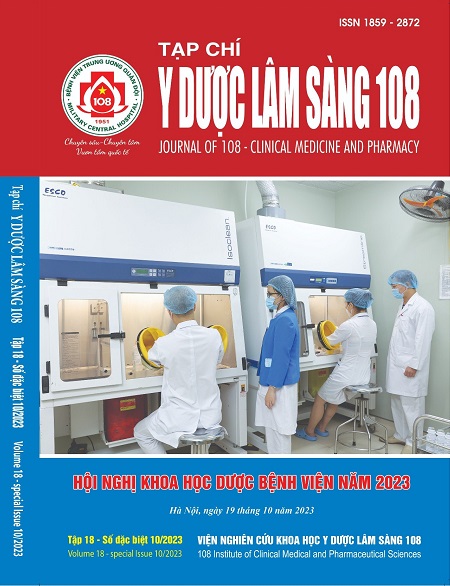Đặc điểm kháng kháng sinh và các yếu tố liên quan đến kết quả điều trị ở bệnh nhân nhiễm khuẩn bệnh viện tại Khoa Hồi sức tích cực, Bệnh viện Đa khoa tỉnh Vĩnh Phúc
Main Article Content
Keywords
Tóm tắt
Mục tiêu: Xác định tỷ lệ kháng kháng sinh của các vi khuẩn thường gặp gây NKBV và một số yếu tố liên quan đến kết quả lâm sàng và điều trị NKBV tại khoa HSTC, Bệnh viện Đa khoa tỉnh Vĩnh Phúc. Đối tượng và phương pháp: Nghiên cứu tiến cứu, mô tả cắt ngang ở 76 bệnh nhân được chẩn đoán NKBV tại khoa Hồi sức tích cực (HSTC), Bệnh viện Đa khoa tỉnh Vĩnh Phúc từ 01/2021 đến 09/2021. Kết quả: Căn nguyên gây bệnh chủ yếu là A. baumannii (34,4%), P. aeruginosa (18,8%) và K. pneumoniae (15,6%) với tỷ lệ kháng kháng sinh với nhóm cephalosporin, quinolon, aminoglycosid, carbapenem từ 50%-100% và kháng thấp hơn với nhóm colistin (11,1%- 33%). Các BN bị NKBV có tỷ lệ tử vong (56,6%), tỷ lệ sốc nhiễm khuẩn (43,4%) cao và thời gian điều trị kéo dài (18 ± 9 ngày). Các yếu tố liên quan đến nguy cơ tử vong và nguy cơ sốc nhiễm khuẩn là bệnh nhân có bệnh lý nền trước đó, dùng thuốc trong 30 ngày qua, các thủ thuật xâm lấn và điều trị kháng sinh theo kinh nghiệm không hợp lý. Kết luận: Căn nguyên gây bệnh thường gặp trong NKBV là các vi khuẩn đa kháng kháng sinh. Bệnh nhân có bệnh lý nền, các can thiệp thủ thuật và điều trị kháng sinh theo kinh nghiệm là các yếu tố liên quan đến kết quả điều trị của bệnh nhân
Article Details
Các tài liệu tham khảo
2. Hsueh PR, Chen WH, Luh KT (2010) Relationships between antimicrobial use and antimicrobial resistance in Gram-negative bacteria causing nosocomial infections from 1996-2008 at a university hospital in Taiwan. International Journal of Antimicrobial Agents 26: 463-472. doi: 10.1016/j.ijantimicag.2010.08.016.
3. Alfouzan W, Dhar R, Abdo NM, Alali WQ, Rabaan AA (2021) Epidemiology and microbiological profile of common healthcare associated infections among patients in the Intensive Care Unit of a General Hospital in Kuwait: A Retrospective Observational Study. Journal of Epidemiology and Global Health Vol. 11(3): 302-309 DOI: https://doi.org/10.2991 /jegh.k.210524.001; ISSN 2210-6006.
4. Otero ML, Menezes RC, Ferreira IBB, Issa FL, Agareno G, Carmo TA, Arriaga MB, Fukutani KF, Pamplona Neto L, Agareno S, Filgueiras Filho NM, Akrami KM, Andrade BB (2020) Factors Associated with Mortality in Critically Ill Patients Diagnosed with Hospital Acquired Infections. Infection and Drug Resistance 2020:13 2811-2817.
5. Duong Bich Thuy, James Campbell, Le Thanh Hoang Nhat (2018) Hospital-acquired colonization and infections in a Vietnamese intensive care unit. PLOS ONE. https://doi.org/10.1371/journal. pone.0203600.
6. CDC (2019) HAI Data and Statistics. CDC's National Healthcare Safety Network (NHSN).
7. Etemad M, Khani Y, Hashemi-Nazari SS et al (2021) Survival rate in patients with ICU-acquired infections and its related factors in Iran’s hospitals. Etemad et al. BMC Public Health 21: 787.https://doi.org/10.1186/s12889-021-10857-y.
8. Despotovic A, Milosevic B, Milosevic I, Mitrovic N, Cirkovic A, Jovanovic S, Stevanovic G (2020) Hospital-acquired infections in the adult intensive care unit Epidemiology, antimicrobial resistance patterns, and risk factors for acquisition and mortality. American Journal of Infection Control 48: 1211-1215. https://doi.org/10.1016/j.ajic.2020.01.009.
9. Aydogdu M, Gursel G (2010) Predictive Factors for Septic Shock in Patients with Ventilator-Associated Pneumonia. Southern Medical Journal. 101.12.2010.
 ISSN: 1859 - 2872
ISSN: 1859 - 2872
